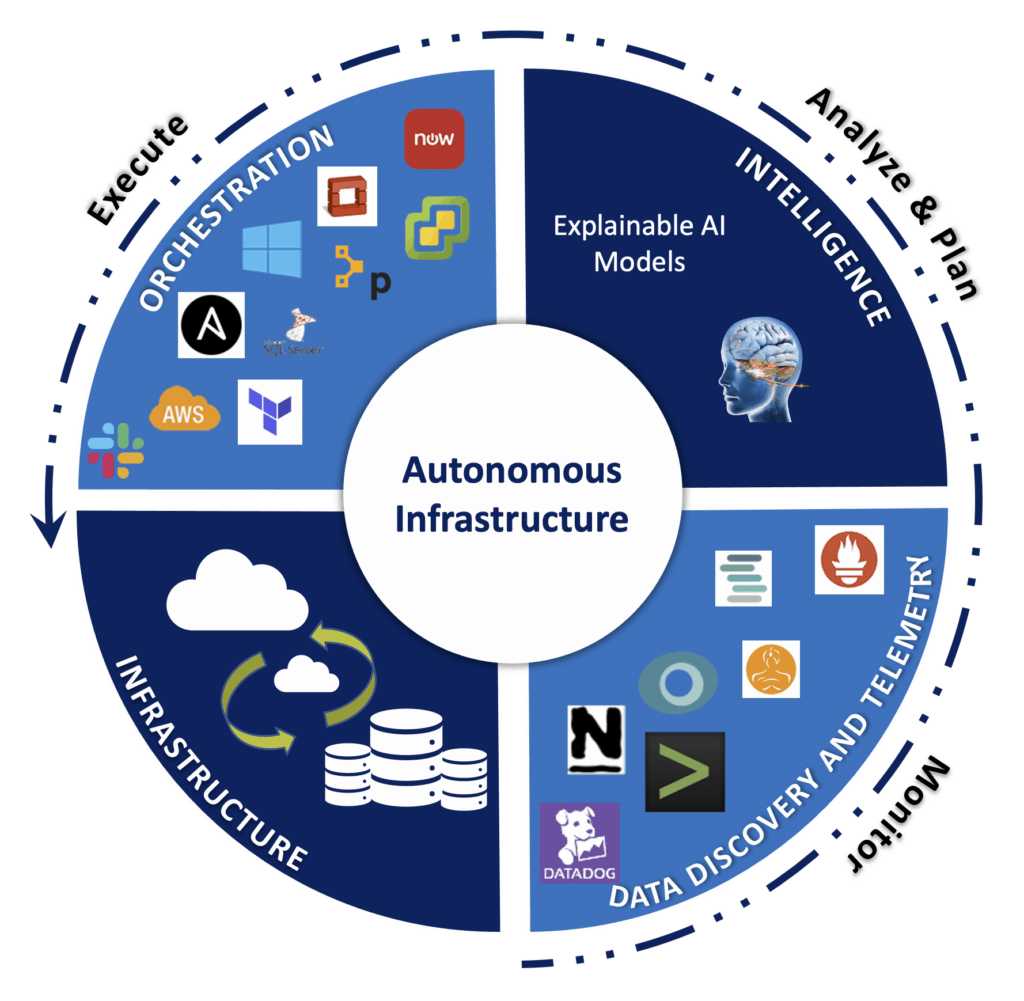
In line with the fast-advancing age of digital transformation, companies are expected to stay up to speed with many new paradigm shifts, seeking greater agility and efficiency within their infrastructure operation teams. This presents both a challenge and an opportunity for infrastructure and operations teams to address and ease their growing number of complex tasks and workflows.
Infrastructure orchestration and monitoring are key building blocks that help alleviate common pain points, maintaining and automating the numerous processes rendered across multiple platforms. To take your solution to the next level and for optimal and accurate coordination across your company, we introduce the Autonomous Infrastructure.
Similar to a self-driving car’s operations, the Autonomous Infrastructure represents the self-driving infrastructure of our time and era. Powered by XAI, or eXplainable AI, it identifies and reduces anomalies through auto-remediation in cross-domain workflows, reducing time and resources needed to carry out tasks, and optimizing general processes. Leveraging XAI capabilities, and getting away from the years of black box AI/ML solutions, Autonomous Infrastructure is not only the self-driving infrastructure, it also ensures that IT professionals can fully understand and trust the AI/ML decisions being made.
Let’s take a closer look at how the Autonomous Infrastructure functions along a MAPE loop platform built to navigate your digitalization journey.

The intelligence portion of the Autonomous Infrastructure is powered by an eXplainable AI, or XAI, Engine. The brain, as we like to call it, analyzes and delivers intelligent persona-based recommendations and decisions based on the infrastructure’s state, through the help of real-time and historical knowledge-based data. The brain executes predictive algorithms with patterns and events to detect and flag abnormalities. It must also generate a real-time impact analysis and provide insights as to how, when, and where to optimize resource utilization within the infrastructure.
The focus will be on using explainable AI by displaying persona-based views to give context for the brain’s decisions. XAI allows all AI/ML decisions to be explainable based on causation and not just correlation while having a persona-based approach allows IT managers, CIO’s, and data scientists to all have the ability to easily see the most important information for each persona regarding why the XAI engine made the decision or what the outcome, and any affected services, of a recommendation, will be. This is paramount for enabling the growth of AI within your infrastructure as this explainability is the baseline for building trust between the AI engine and your infrastructure teams.
The focus of the brain is to intelligently make a decision based on data from the eyes (data discovery) and to then guide the brawn (event-driven workflow orchestration) to complete any necessary proactive or reactive remediations necessary to maintain the state of the Autonomous Infrastructure.
Enabled via a vendor-agnostic data discovery engine, the eyes and ears are in charge of compiling all of the real-time stateful data derived from the infrastructure and making it available to the “Brain”. To enable an Autonomous Infrastructure, you will need real-time data on all aspects of your infrastructure so that your explainable AI can create causal inferences related to a diversity of business support systems. This is a large-scale discovery need, spanning from hybrid cloud environments, container environments, physical switches, all the way down to temperature sensors and fan controllers.
The eyes and ears of the solution are meant to make sure that the brain has a single data lakehouse that consists of any and all information necessary to make intelligent automated decisions. As with causal inferences enabled by explainable AI, with more data points you will get clearer and clearer visibility into exactly what actions should be taken and what the affected endpoints are for every event and action.
The brawn of the solution must be handled by a cross-domain event-driven workflow orchestration tool powered by multi-domain integrations to ensure that any infrastructure component can be automated or added anywhere needed into an orchestration workflow. The focus of the brawn is not to be a specific silo orchestrator, it is to be as generic as possible with the plug-and-play ability for any new technology stacks that rise up in the future.
Taking a vendor-agnostic approach is key for your Orchestration tool, this allows you to consume existing siloed domain-specific automation scripts and combine them into integrated workflows that can span your Infrastructure. A vendor-agnostic approach allows for ease of mind as you no longer need to rip-and-replace existing well-tested tools.
Bringing together the brain, the eyes and the brawn into one solution yields results greater than the sum of the parts; delivering the promise of Autonomous Infrastructure, enabling infrastructure and operations teams to deliver business value at scale while enhancing enterprise performance.
It is imperative that infrastructure teams and business leaders across all industries adopt new methodologies to assure that business objectives and digital transformation needs are accurately met. Autonomous Infrastructure delivers a solution with the power of XAI controlling cross-domain orchestration tools to help mitigate the challenge of blindly trusting AI/ML decisions while providing the ability to identify abnormalities throughout your infrastructure, allowing you to autonomously avoid the iceberg lurking below the surface.